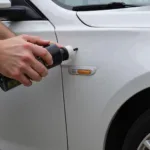Car paint patch repair is a cost-effective solution for minor paint damage, allowing you to address scratches, chips, and scuffs without a full repaint. This guide provides a detailed overview of car paint patch repair, covering everything from identifying the damage to achieving a professional-looking finish. We’ll explore various techniques, tools, and tips to help you restore your car’s appearance. See our guide on car paint repair patches for specific product recommendations.
Assessing the Damage and Choosing the Right Repair Method
Before starting any car paint patch repair, it’s crucial to assess the extent of the damage. Is it a superficial scratch, a deep chip, or a patch of rust? The type and depth of the damage will determine the appropriate repair method. For light scratches, a simple rubbing compound might suffice. Deeper chips might require touch-up paint and clear coat, while rust patches demand more extensive preparation and possibly a rust converter.
Understanding Different Types of Car Paint Damage
- Scratches: These range from clear-coat scratches to deep gouges that penetrate the primer.
- Chips: Stone chips and other impacts can create small, localized areas of missing paint.
- Scuffs: Often caused by minor collisions or scraping against objects, scuffs typically affect the clear coat and paint layers.
- Rust: Rust is a serious issue that requires prompt attention to prevent further damage.
Gathering the Necessary Tools and Materials
Having the right tools and materials is essential for a successful car paint patch repair. You’ll likely need:
- Automotive touch-up paint (matched to your car’s color)
- Primer (if the damage reaches the metal)
- Sandpaper (various grits)
- Rubbing compound
- Polishing compound
- Wax or sealant
- Masking tape
- Microfiber cloths
- Applicators (brushes, foam pads, etc.)
- Rust converter (if necessary)
Learn more about how to effectively use these tools to repair specific paint issues at paint patch repair car.
Choosing the Right Touch-up Paint
Matching the touch-up paint to your car’s original color is crucial for a seamless repair. Check your owner’s manual for the paint code or look for a sticker inside the driver’s side doorjamb. Automotive stores can typically mix the exact color for you.
Step-by-Step Guide to Car Paint Patch Repair
- Clean the area: Thoroughly wash and dry the damaged area.
- Sand the damaged area: Start with a coarser grit sandpaper and gradually move to finer grits to smooth the surface.
- Apply primer (if needed): If bare metal is exposed, apply a thin coat of primer.
- Apply touch-up paint: Apply thin coats of touch-up paint, allowing each coat to dry before applying the next.
- Apply clear coat (if needed): If the original paint had a clear coat, apply a few thin coats to the repaired area.
- Sand and polish: Once the clear coat is dry, wet sand with fine-grit sandpaper and then polish to a high gloss.
- Wax or seal: Protect the repaired area with a coat of wax or sealant.
For more detailed instructions and tips on repairing small paint patches, visit how to repair small paint patches on a car.
Common Car Paint Patch Repair Mistakes to Avoid
- Applying too much paint at once, leading to runs and drips.
- Not properly matching the touch-up paint color.
- Failing to prepare the surface adequately.
- Using the wrong type of sandpaper.
- Not allowing sufficient drying time between coats.
“A common mistake is using incorrect sandpaper grit. Starting with too fine a grit won’t effectively smooth the surface, while finishing with too coarse a grit will leave visible scratches,” says automotive expert, John Miller, certified mechanic at Miller’s Auto Repair.
When to Call a Professional
While minor car paint patch repairs can be handled DIY, more extensive damage or rust repair is best left to professionals. If you’re unsure about tackling the repair yourself, consult a qualified auto body shop.
“Don’t hesitate to seek professional help for complex repairs or if you’re uncomfortable working with paint. A professional can ensure a flawless, long-lasting finish,” advises Sarah Chen, Lead Paint Technician at Chen’s Auto Body. Check out our article on patch repair car paint for more information.
Conclusion
Car paint patch repair is a valuable skill for any car owner. By following the steps outlined in this guide and avoiding common mistakes, you can effectively address minor paint damage and restore your car’s appearance. Remember, proper preparation and patience are key to achieving professional-looking results. For more information on dealing with rust-related paint damage, check out rust patch paint repair car.
FAQ
-
How long does touch-up paint take to dry?
Typically, touch-up paint takes 30-60 minutes to dry to the touch, but complete curing can take several days. -
Can I use nail polish for car paint patch repair?
No, nail polish is not formulated for automotive use and will not adhere properly or provide adequate protection. -
How can I prevent rock chips?
Maintaining a safe following distance and applying paint protection film can help prevent rock chips. -
What is the best way to remove scratches from car paint?
The best method depends on the severity of the scratch. Light scratches can often be removed with rubbing compound, while deeper scratches might require professional attention. -
Can I wax my car after a car paint patch repair?
Yes, waxing your car after the repair is completely cured will provide added protection and shine.
Common Car Paint Patch Repair Scenarios
- Scenario 1: Small rock chip on the hood.
- Scenario 2: Scratch on the door from a key.
- Scenario 3: Scuff mark on the bumper from a minor parking lot incident.
Related Articles
- How to choose the right car wax.
- DIY car detailing tips and tricks.
- Understanding different types of car paint.
Need help with your car’s paint? Contact us via WhatsApp: +1(641)206-8880 or Email: [email protected]. Our 24/7 customer support team is ready to assist you.


